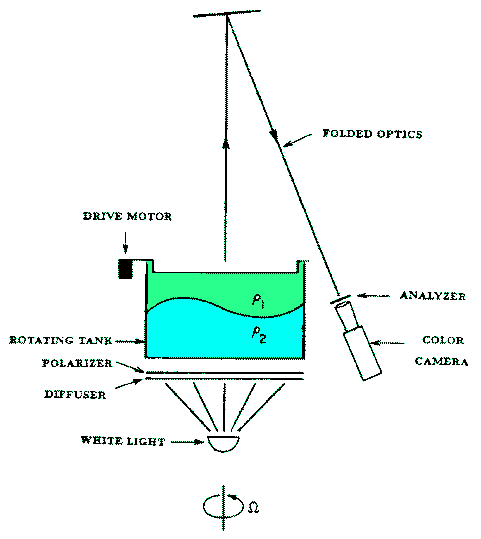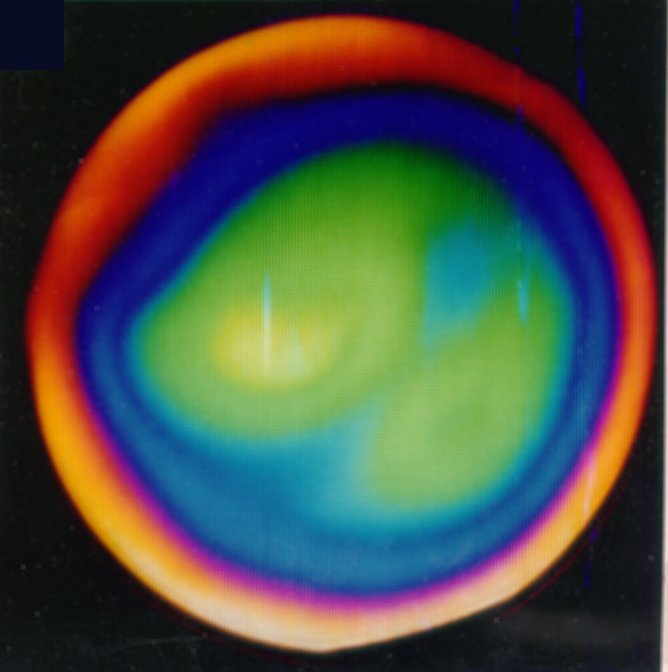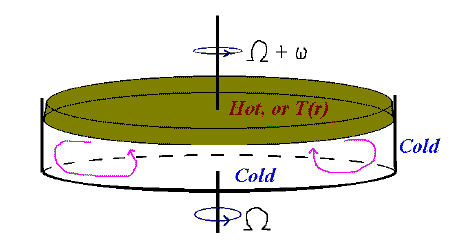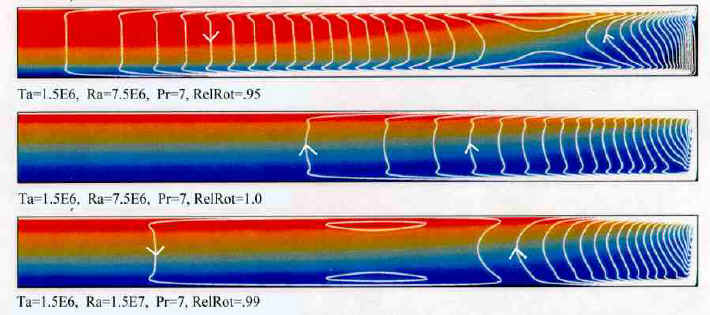|
OCEAN MODELING
Geophysical Fluid Dynamics Laboratory, Univ. of Colorado Laboratory experiments have played an important role in the development of our understanding of atmospheric and oceanic dynamics. The rotating annulus experiment was developed in the 1950's as a prototype for the atmospheric general circulation. It continues to this day to provide experimental observations of flows in a rotating environment that are driven by a lateral ("north-south") temperature gradient. To model large-scale ocean flows, it is necessary to include mechanical forcing at the upper surface in order to simulate the action of wind stress driving of ocean gyres. The first experiments to do this in a stratified fluid were developed in our laboratory and used two immiscible layers (oil and water), with the boundary between them representing the thermocline. Studies of baroclinic instability and nonlinear wave processes were facilitated by an optical polarimetry visualization method. White light propagating up through an optically active fluid (Limonene - basically distilled orange peels) has its polarization rotated. The degree of optical rotation depends on the wavelength (blue light is rotated more) and on the depth of the layer. Color imaging of the system yields pictures of the interface (thermocline) deflections - revealing wave amplitude, shapes, and interactions.
Optical polarimetry of a 2-layer rotating fluid model of an ocean gyre. The whole system rotates and the drive motor generates relative fluid motion in the container via a contact glass lid.
Sample image showing a wavenumber 2 disturbance.
We are currently building a model that generalizes the two layer system to one with continuous stratification. Mechanical forcing is still present using a differentially rotating lid, but thermal forcing at the boundaries leads to a temperature field in the bulk of the fluid that is determined dynamically. This may be compared with the two-layer system in which the stratification is set by the types of fluids used.
Schematic of the wind and buoyancy driven gyre experiment. Only one type of many possible thermal excitation boundary conditions are illustrated. An important question is precisely what sort of axisymmetric circulation will develop in such a system that is driven both mechanically and thermally. In collaboration with Nic Brummell and John Lopez we have constructed an axisymmetric numerical model to investigate this question. In general the mechanical forcing tends to generate a thermocline over the bulk of the fluid. This is located either at the top or near the bottom, depending on the sign of the differential rotation of lid (cyclonic forcing produces a thermocline near the top). The sidewall thermal forcing generates a circulation of its own, that can dominate the whole gyre if the wind-stress analog is weak compared to the imposed thermal stress. An example with an anti-cyclonic lid rotation, and a cold sidewall is shown below.
Meridional streamlines and temperature distribution (red = hot, black = cold) for anticyclonic surface forcing and a cold sidewall. Image shows the right hand quarter of a cell of aspect ratio 1 high to 10 wide. The sidewall circulation (up, just off the right hand wall "coast") is opposite to the sense of the mechanically forced circulation (down, left hand side of the panel). The outflow boundary layer at the bottom separates at a distance of about 0.7 radii. The diagrams below indicate how these flows depend on parameters.
When the top lid rotates slower then the rest of the cylinder rotate we say that the the Relative Rotation is less than 1. (RelRot = top lid rotation rate / cylinder rotation rate). This anticyclonic forcing drives a bulk gyre that advects hot fluid downwards, creating a thermocline at the bottom (top panel). With no mechanical forcing the sidewall driven convection cell advects cold fluid upwards over most of the cell located away from the sidewall at the right side (middle). For certain Rayleigh numbers (measuring the strength of the convection) and RelRot parameters there is a competition between the convection influence, which generates a thermocline at the top, and the mechanical anticyclonic forcing,which generates a thermocline at the bottom. Experiments, theory, and numerical simulations are being carried out to determine how the thermocline location and extent depends on external parameters. What non-axisymmetric instabilities will be associated with such gyres? Will they be concentrated near the outer edge of the gyre as found in the Arctic? What effect will eddies have on the mean circulation? These questions are currently under study using both laboratory and computational modeling. Portions of this research is sponsored by National Science Foundation, Physical Meteorology Division of the Atmospheric Sciences Program.
|




